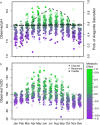Ecosystem metabolism drives pH variability and modulates long-term ocean acidification in the Northeast Pacific coastal ocean
- PMID: 30700764
- PMCID: PMC6353961
- DOI: 10.1038/s41598-018-37764-4
Ecosystem metabolism drives pH variability and modulates long-term ocean acidification in the Northeast Pacific coastal ocean
Abstract
Ocean acidification poses serious threats to coastal ecosystem services, yet few empirical studies have investigated how local ecological processes may modulate global changes of pH from rising atmospheric CO2. We quantified patterns of pH variability as a function of atmospheric CO2 and local physical and biological processes at 83 sites over 25 years in the Salish Sea and two NE Pacific estuaries. Mean seawater pH decreased significantly at -0.009 ± 0.0005 pH yr-1 (0.22 pH over 25 years), with spatially variable rates ranging up to 10 times greater than atmospheric CO2-driven ocean acidification. Dissolved oxygen saturation (%DO) decreased by -0.24 ± 0.036% yr-1, with site-specific trends similar to pH. Mean pH shifted from <7.6 in winter to >8.0 in summer concomitant to the seasonal shift from heterotrophy (%DO < 100) to autotrophy (%DO > 100) and dramatic shifts in aragonite saturation state critical to shell-forming organisms (probability of undersaturation was >80% in winter, but <20% in summer). %DO overwhelmed the influence of atmospheric CO2, temperature and salinity on pH across scales. Collectively, these observations provide evidence that local ecosystem processes modulate ocean acidification, and support the adoption of an ecosystem perspective to ocean acidification and multiple stressors in productive aquatic habitats.
Conflict of interest statement
The authors declare no competing interests.
Figures




Similar articles
-
Effects of warming, eutrophication and climate variability on acidification of the seasonally stratified North Yellow Sea over the past 40 years.Sci Total Environ. 2022 Apr 1;815:152935. doi: 10.1016/j.scitotenv.2022.152935. Epub 2022 Jan 8. Sci Total Environ. 2022. PMID: 35007597
-
Severe biological effects under present-day estuarine acidification in the seasonally variable Salish Sea.Sci Total Environ. 2021 Apr 15;765:142689. doi: 10.1016/j.scitotenv.2020.142689. Epub 2020 Oct 6. Sci Total Environ. 2021. PMID: 33077233
-
Environmental salinity modulates the effects of elevated CO2 levels on juvenile hard-shell clams, Mercenaria mercenaria.J Exp Biol. 2013 Jul 15;216(Pt 14):2607-18. doi: 10.1242/jeb.082909. Epub 2013 Mar 26. J Exp Biol. 2013. PMID: 23531824
-
Natural and Anthropogenic Drivers of Acidification in Large Estuaries.Ann Rev Mar Sci. 2021 Jan;13:23-55. doi: 10.1146/annurev-marine-010419-011004. Epub 2020 Sep 21. Ann Rev Mar Sci. 2021. PMID: 32956015 Review.
-
Hypoxia and acidification in ocean ecosystems: coupled dynamics and effects on marine life.Biol Lett. 2016 May;12(5):20150976. doi: 10.1098/rsbl.2015.0976. Biol Lett. 2016. PMID: 27146441 Free PMC article. Review.
Cited by
-
Coast-wide evidence of low pH amelioration by seagrass ecosystems.Glob Chang Biol. 2021 Jun;27(11):2580-2591. doi: 10.1111/gcb.15594. Epub 2021 Mar 31. Glob Chang Biol. 2021. PMID: 33788362 Free PMC article.
-
Factors limiting oyster growth in Willapa Bay (Washington, USA) evaluated with in situ feeding experiments.Heliyon. 2021 Jan 6;7(1):e05878. doi: 10.1016/j.heliyon.2020.e05878. eCollection 2021 Jan. Heliyon. 2021. PMID: 33490666 Free PMC article.
-
Exposure of larval pinto abalone to ocean acidification and warming negatively impacts survival, settlement, and size.Sci Rep. 2025 May 6;15(1):15797. doi: 10.1038/s41598-025-96605-3. Sci Rep. 2025. PMID: 40328860 Free PMC article.
-
Effect of nutrient reductions on dissolved oxygen and pH: a case study of Narragansett bay.Front Mar Sci. 2024 May 23;11:1374873. doi: 10.3389/fmars.2024.1374873. Front Mar Sci. 2024. PMID: 40177612 Free PMC article.
-
Key benthic species are affected by predicted warming in winter but show resistance to ocean acidification.Ecol Evol. 2024 Sep 18;14(9):e70308. doi: 10.1002/ece3.70308. eCollection 2024 Sep. Ecol Evol. 2024. PMID: 39296734 Free PMC article.
References
-
- Aufdenkampe AK, et al. Riverine coupling of biogeochemical cycles between land, oceans, and atmosphere. Front. Ecol. Environ. 2011;9:53–60. doi: 10.1890/100014. - DOI
-
- Cloern JE. Our evolving conceptual model of the coastal eutrophication problem. Mar. Ecol. Prog. Ser. 2001;210:223–253. doi: 10.3354/meps210223. - DOI
-
- Boyd P, Hutchins D. Understanding the responses of ocean biota to a complex matrix of cumulative anthropogenic change. Mar. Ecol. Prog. Ser. 2012;470:125–135. doi: 10.3354/meps10121. - DOI
LinkOut - more resources
Full Text Sources

